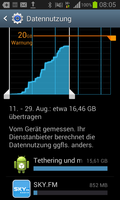 In a previous post I wrote down my first impressions on the Banana Pi and how it would fare as a platform for Owncloud. While the general message was 'quite well' there was no room in the post for more detailed benchmark results. So here we go:
In a previous post I wrote down my first impressions on the Banana Pi and how it would fare as a platform for Owncloud. While the general message was 'quite well' there was no room in the post for more detailed benchmark results. So here we go:
To see how the Banana Pi costing €75 with casing and SD card fares compares to a slower Raspberry Pi costing €50 (with casing and SD card) and a faster Intel NUC based Owncloud installation costing around €200, I ran a number of everyday use cases on all three of them. The picture on the left shows my setup for a direct comparison between the Banana Pi and the Raspberry Pi. The NUC was not on the table for the test but connected over Wi-Fi. Obviously that reduces the data transfer speeds to and from the NUC somewhat but probably not by much.
On all three systems I've used https. It doesn't seem to have a big impact, however as the multiple file upload test described below didn't show a performance difference between the use http and https. On the Banana Pi, all data was put on the SD card, i.e. no external SATA drive was connected. This would have perhaps made the Banana Pi faster but my usage scenario is to have a small Owncloud box without external hardware to keep cost and space requirements down.
Login Test
My first test focused on how long it takes to log into an Owncloud user account after the Owncloud server has been rebooted. The time it takes is similar to the time it takes to log in after having logged out. I ran the same test three times on the Raspberry Pi and the Banana Pi to show that there is a certain variance.
- NUC: 5 seconds
- Raspberry Pi: 43 seconds, 41 seconds, 48 seconds
- Banana Pi: 7 seconds, 7 seconds, 14 seconds
Speed-up compared to the Raspi: approx. 6x
File Uploads
 For this test I uploaded 38 images with a size of around 3 MB each on each Owncloud instance. After each upload an icon was generated that is shown next to the filename. The second picture on the left shows a side by side comparison of the upload progress on the Raspberry Pi and the Banana Pi respectively.
For this test I uploaded 38 images with a size of around 3 MB each on each Owncloud instance. After each upload an icon was generated that is shown next to the filename. The second picture on the left shows a side by side comparison of the upload progress on the Raspberry Pi and the Banana Pi respectively.
- NUC: 65 seconds (1 minute 5 seconds)
- Raspberry Pi: 420 seconds (7 minutes)
- Banana Pi: 142 seconds (2 minutes 20 seconds)
Speed-up compared to the Raspi: approx. 3x
Link download screen shown after reboot
Another important scenario is how long it takes for a download page to be shown to someone to whom I've sent a link for a shared file. To make sure there is no buffering, I rebooted the two Pis before each run.
- NUC: 5 seconds, 4 seconds
- Raspberry Pi: 32 seconds, 26 seconds
- Banana Pi: 8 seconds, 6 seconds
Speed-up compared to the Raspi: approx. 4x
Summary
The results show quite nicely that the Banana Pi runs an Owncloud instance much faster than a Raspberry Pi. The time it takes to log in, to upload files and to open a shared link is not as short as on a NUC but from my point of view it is still fast enough to be usable.





